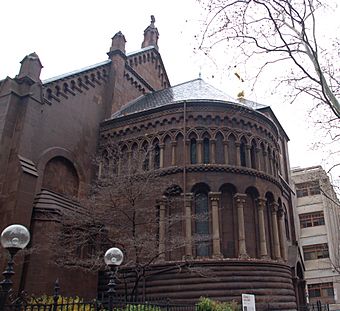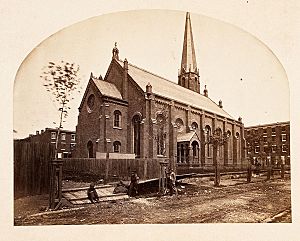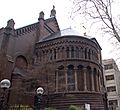Saint Clement's Church (Philadelphia) facts for kids
Quick facts for kids |
|
|
Saint Clement's Church
|
|
 |
|
| Location | 2013 Appletree Street Philadelphia, Pennsylvania, U.S. |
|---|---|
| Built | 1856–1859 |
| Architect | John Notman |
| Architectural style | Romanesque Revival |
| NRHP reference No. | 70000555 |
| Added to NRHP | 1970 |
Saint Clement's Church is a very old and important church in Philadelphia, Pennsylvania. It's located in the Logan Square area of Center City. This church is part of the Episcopal faith, which is a Christian church.
The church building was designed by a famous architect named John Notman and was built starting in 1856. It originally had a very tall spire, like a tall, pointed roof, that was over 200 feet (about 61 meters) high. But this spire was too heavy for the church's foundation, so it had to be taken down in 1869.
In 1929, something amazing happened: the entire church building, which weighs about 5,000 tons, was lifted up! It was then moved 40 feet (about 12 meters) to the west. This big move was done to make room for a wider street. Saint Clement's Church was recognized as a special historic place on November 20, 1970, when it was added to the National Register of Historic Places.
Contents
The Church's Story
Saint Clement's Church officially started on September 13, 1855. The first leader of the church was Reverend Henry S. Spackman. The very first stone of the church building was placed on May 12, 1856.
The land for the church was given by a man named William S. Wilson. He was a wealthy businessman who owned a lot of land in that part of Philadelphia. He wanted a church built there because he thought it would make the houses he was building nearby more attractive to buyers.
Building the Church
John Notman, the architect, designed Saint Clement's Church. He also designed other churches in Philadelphia. He believed that different church styles suited different types of worship. Saint Clement's was built in the Romanesque Revival style, which uses rounded arches and strong, heavy walls. Like some of his other churches, Saint Clement's was built using brownstone.
When the church was being built, the area around it was mostly open fields. There weren't many houses nearby, and the city streets hadn't spread out that far west yet. The building of the church took three years because there were often money problems. At one point, all work stopped, and the building stood without a roof for a long time. Finally, the church opened for services in January 1859. It was officially dedicated on April 12, 1864.
Changes in Worship Style
In 1869, a new leader named Hermon Griswold Batterson arrived. During his time, the church started to adopt new ways of worship, influenced by a movement called the Oxford Movement. This meant they began using more traditional practices, like wearing special colorful robes during services, placing lit candles on the altar, and kneeling during prayers. They also encouraged private confession and prayers for those who had passed away.
These changes caused some disagreements within the church. Some people liked the new ways, while others did not. Eventually, the church leaders decided to support the new, more traditional style of worship.
Helping the Community
From 1876 to 1891, a group of priests known as the Cowley Fathers helped lead Saint Clement's. They were very active in helping the poor and needy people in Philadelphia. One of these priests, Father Charles Neale Field, started a group called the Guild of the Iron Cross for Working Men and Boys. This group helped thousands of working men from all over the United States. It was a place for fun activities and religious lessons. The church was close to many factories, so many working families were part of the church and the guild.
It's also believed that Saint Clement's was one of the first churches in the city to welcome people of all backgrounds, including African-Americans. Unlike some other churches, Saint Clement's never created a separate church for African-Americans. Father Field was known for helping all people, which showed the church's long history of being welcoming to everyone.
The church also worked to open a hospital for adults. They started with a small clinic in 1885, offering evening hours so working people could get help. The only rule was that you had to be poor and sick to get treatment. The hospital grew, but it became too expensive for the church to run. Later, the building was sold to a group of nuns to be used as a mission house.
A New Era of Growth
In 1895, Reverend George Herbert Moffett became the new leader. Under his guidance, the church became more successful. He built a new house for the clergy (the priests) and introduced new traditions, like keeping the Blessed Sacrament (a special part of their worship) in the church at all times. He also started using the term "Mass" officially for their main service. Saint Clement's was the first church in its diocese to do this.
Over time, the neighborhood around Saint Clement's changed. Many factories closed, and families moved away. The church then became more of a "shrine church." This means people from all over, even far away, would travel to attend its traditional services, especially on important holidays.
Today, the neighborhood is growing again with new people moving in. Saint Clement's continues to be a welcoming church that follows its traditional Anglo-Catholic practices. It offers beautiful worship services with music, incense, bells, and a professional choir. Mass is celebrated daily, and on Sundays, it includes classical music.
Church Design
The way Saint Clement's Church was built is quite interesting because of its location. Usually, the main entrance of a church faces west, and the rounded end (called the apse) faces east. But because of where the church was built, the architect, John Notman, put the apse on the east side, which became part of the main front of the church.
The front of the church has a large bell tower and the rounded apse. The apse has a decorative design with simple columns and rounded arches. There are also large stained glass windows. The bell tower used to have a very tall spire, over 200 feet high, but it was removed in 1869 because it was too heavy for the church's foundation.
The main part of the church, called the nave, is very tall. The windows are set in arched sections, typical of the Romanesque style. The roof of the church is made of gray slate. At both ends of the roof, there are small decorative towers made of brownstone, each with a stone cross on top.
In the early 1900s, the roof of the apse was raised about 15 feet. This was done to make room for a large, beautiful artwork called a triptych that now stands above the main altar. Around the same time, the roof of the nave was completely rebuilt because the original one was old and unsafe.
The Big Move
In 1929, the City of Philadelphia decided to make North 20th Street wider. Saint Clement's Church was right in the way! Instead of tearing down the church, the leaders decided to move it. They bought and tore down two houses next to the church. Then, the huge 5,000-ton church building was lifted onto steel beams and moved 40 feet to the west onto a new foundation. This amazing move happened between July 11 and July 16, 1929.
Inside the church, a large, carved oak screen and triptych, installed in 1908, stand above the main altar. The triptych shows Jesus on the cross, with the Blessed Virgin Mary and Saint John the Apostle at the bottom. There is also a special area called the Lady Chapel with an altar and statues of the Virgin Mary, Saint Joseph, and Saint Elizabeth with Saint John the Baptist.
In the main part of the church, there is a tall shrine dedicated to Our Lady of Clemency, featuring a statue of the Virgin Mary as the Queen of Heaven. There are also shrines dedicated to the church's main patron, Pope Clement I, and to Saint Catherine of Alexandria. The church also has a large pipe organ, which was first installed in 1914.
Worship Services
Saint Clement's Church uses a special prayer book called the English Missal for its services. This book is an English translation of older Catholic services. A shorter service, called Low Mass, is offered every day. A longer, more formal service, called High Mass or Sung Mass, is celebrated every Sunday and on most major holidays. From Monday to Saturday, Evening Prayer is said, followed by special prayers at the Shrine of Our Lady of Clemency.
Church Leaders
- Henry S. Spackman, 1856–1863
- Treadwell Walden, 1863–1868
- Hermon Griswold Batterson, 1869–1872
- Theodore M. Riley, 1872–1875
- Oliver Sherman Prescott SSJE, 1876–1881
- Basil W. Maturin SSJE, 1881–1889
- Duncan Convers SSJE, 1889–1891
- John Metcalf Davenport, 1891–1893
- Alfred Bowyer Sharpe, 1893–1895
- George Herbert Moffett, March 1895 – November, 1904
- Charles S. Hutchinson, 1905–1920
- Franklin Joiner, 1920–1955
- William Elwell, 1955–1964
- Edward Oscar Hendricks, 1965–1978
- Francis C. FitzHugh, SSC, 1979–1984
- Peter Laister, 1986–1993
- Barry E. B. Swain SSC 1993–2001
- W. Gordon Reid, 2004–2014
- Richard Alton, 2014–2024
Images for kids
See also








